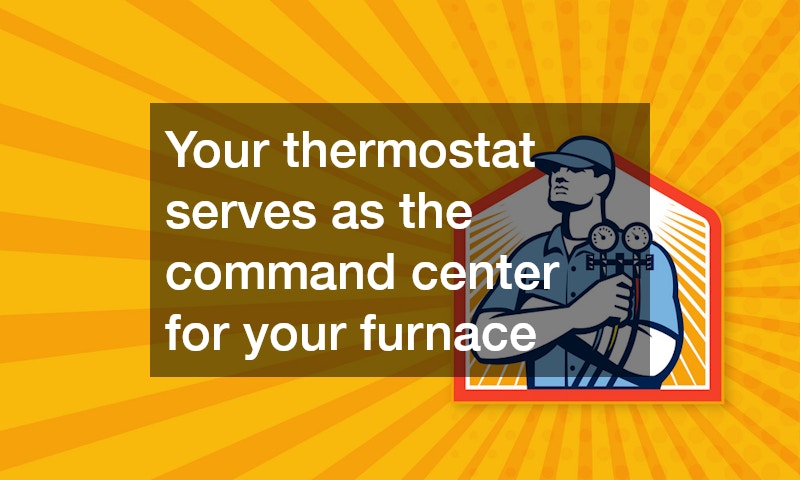When considering the efficiency and reliability of a home heating system, the thermostat often plays an overlooked yet critical role. Acting as the communication hub between you and your furnace, the thermostat controls how and when your home is heated. If it malfunctions or is improperly set, it can lead to performance issues, inefficiencies, and even unnecessary furnace repairs. Understanding how the thermostat interacts with your furnace can help homeowners maintain their systems more effectively and avoid costly complications.
The Thermostat as the Furnace’s Command Center
Your thermostat serves as the command center for your furnace, dictating when it turns on, how long it runs, and at what temperature it maintains your home. When you set your desired temperature, the thermostat measures the current indoor temperature and signals the furnace to produce heat if needed. Once the temperature reaches the desired level, the thermostat tells the furnace to shut off.
If the thermostat is malfunctioning, it may send incorrect signals or fail to communicate with the furnace altogether. This can result in issues such as short cycling, where the furnace turns on and off frequently, or continuous operation, which wastes energy. A properly functioning thermostat ensures that your furnace operates efficiently and provides consistent comfort throughout your home, confirming the lack of need for furnace repairs.
Common Thermostat Issues That Impact Furnace Performance
Several thermostat-related problems can affect furnace performance and may even necessitate repairs:
- Incorrect Calibration: A poorly calibrated thermostat may misread the indoor temperature, causing the furnace to run unnecessarily or fail to turn on when heat is needed.
- Dead Batteries: For battery-operated models, low or dead batteries can disrupt the thermostat’s ability to communicate with the furnace.
- Outdated Thermostats: Older, manual thermostats may lack the precision and features of modern digital or programmable models, leading to less efficient heating.
- Wiring Problems: Faulty or loose wiring can interrupt the connection between the thermostat and the furnace, causing inconsistent performance or complete system failure.
Addressing these issues promptly can prevent further strain on your furnace and restore efficient operation with timely furnace repairs. In many cases, a simple thermostat repair or replacement resolves the problem without requiring extensive work on the furnace itself.
The Connection Between Thermostat Settings and Energy Efficiency
The way you use your thermostat directly impacts your furnace’s energy efficiency and overall performance. Setting the thermostat too high or frequently adjusting the temperature can force the furnace to work harder, increasing wear and tear on its components. For example, setting your thermostat to 80°F during winter may lead to higher energy bills and unnecessary strain on the system.
Programmable and smart thermostats offer a solution by allowing homeowners to schedule temperature adjustments based on their routines. For instance, lowering the temperature while you’re away from home and raising it before you return reduces energy usage without sacrificing comfort. Additionally, many smart thermostats learn your habits over time and make automatic adjustments to optimize efficiency.
Using your thermostat wisely not only improves furnace performance without the need for constant furnace repairs but also extends its lifespan by reducing the frequency of cycles and minimizing stress on critical components.
How Thermostat Issues Mimic Furnace Problems
Homeowners often mistake thermostat issues for furnace malfunctions, leading to unnecessary furnace repairs. For example, a furnace that fails to turn on or struggles to maintain consistent heat may actually have no mechanical problems at all. Instead, the thermostat could be misreading the temperature or failing to send the correct signals.
Similarly, short cycling—a common furnace issue—can often be traced back to a malfunctioning thermostat. If the thermostat is incorrectly detecting rapid temperature changes, it may cause the furnace to cycle on and off frequently, which wastes energy and accelerates wear on the system.
When diagnosing furnace problems, HVAC technicians typically start by inspecting the thermostat to rule out simple issues before delving into the furnace itself. Homeowners can save time and money by checking the thermostat’s batteries, settings, and connections before scheduling professional repairs.
The thermostat plays a pivotal role in the performance and reliability of your furnace. As the system’s command center, it regulates when and how your furnace operates, directly impacting energy efficiency, comfort, and the likelihood of furnace repairs. Understanding common thermostat issues, using your settings wisely, and investing in modern technology can significantly enhance your heating system’s performance.
.




